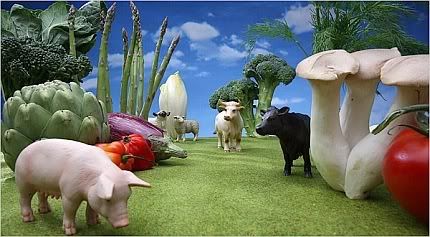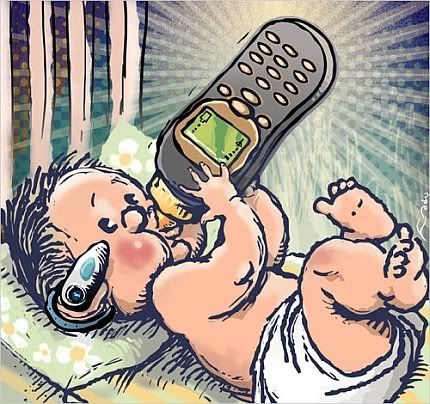Gayadas de Caliman13
caught my eye surfing.....
Saturday, June 21, 2008
Poniendo la carne en su sitio.
Dining & Wine | |
| Putting Meat Back in Its Place By MARK BITTMAN Published: June 11, 2008 | |
 Tony Cenicola/The New York Times | |
| LET'S suppose you've decided to eat less meat, or are considering it. And let's ignore your reasons for doing so. They may be economic, ethical, altruistic, nutritional or even irrational. The arguments for eating less meat are myriad and well-publicized, but at the moment they're irrelevant, because what I want to address here is (almost) purely pragmatic: How do you do it? I'm not talking about eating no meat; I'm talking about cutting back, which in some ways is harder than quitting. Vegetarian recipes and traditions are everywhere. But in the American style of eating with meat usually at the center of the plate it can be difficult to eat two ounces of beef and call it dinner. Cutting back on meat is not an isolated process. Unlike, say, taking up meditation or exercise, it usually has consequences for others. The keys are to keep at least some of your decisions personal so they affect no one but yourself and, when they do affect others, minimize the pain and don't preach. (No one likes a proselytizer.) On the other hand, don't apologize; by serving your friends or family less meat you're certainly doing them no harm, and may be doing them good as long as what you serve is delicious, and that's easy enough. Reducing the meat habit can be done, and it doesn't have to make you crazy. Although there will undoubtedly be times you'll have cravings, they'll never give you the shakes. So, in no particular order, here are some suggestions to ease your path to eating less meat. | |
 Andrew Scrivani for The New York Times TO BE SAVORED, NOT GOBBLED Make the most of less meat, as in kebabs with cauliflower and cherry tomatoes. | |
1. Forget the protein thing. Roughly simultaneously with your declaration that you're cutting back on meat, someone will ask "How are you going to get enough protein?" The answer is "by being omnivorous." Plants have protein, too; in fact, per calorie, many plants have more protein than meat. (For example, a cheeseburger contains 14.57 grams of protein in 286 calories, or about .05 grams of protein per calorie; a serving of spinach has 2.97 grams of protein in 23 calories, or .12 grams of protein per calorie; lentils have .07 grams per calorie.) By eating a variety, you can get all essential amino acids. You also don't have to eat the national average of a half-pound of meat a day to get enough protein. On average, Americans eat about twice as much as the 56 grams of daily protein recommended by the United States Department of Agriculture (a guideline that some nutritionists think is too high). For anyone eating a well-balanced diet, protein is probably not an issue. 2. Buy less meat. How many ounces of meat is a serving? For years, the U.S.D.A.'s recommendation has been four ounces a person, yet most of us have long figured one-and-a-half to two pounds of meat is the right amount for four people. (Our per capita consumption of meat hasn't changed much over the years, and remains at about a half-pound a day.) Change that amount, and both your cooking style and the way the plate looks will change, and quickly. Remember that most traditional styles of cooking use meat as a condiment or a treat. This is true in American frontier cooking, where salt pork and bacon were used to season beans; in Italy, where a small piece of meat is served as a secondo (rarely more than a few ounces, even in restaurants); and around the world, where bits of meat are added to stir-fries and salads, as well as bean, rice and noodle dishes. In all of these cases, meat is seen as a treasure, not as something to be gobbled up as if it were air. For many of us who grew up in the United States in the last 60 years, this is the toughest hurdle. The message (remember "Beef: it's what's for dinner"?) was in our psyche from before we could hold a fork. We may have vegetarian nights, or seafood nights, but when we have meat nights, there's often a big piece of meat (or poultry) on the plate, with starch and vegetable to the side. 3. Get it out of the center of the plate. You don't have to jump into utterly unfamiliar territory; just try tweaking the proportions a bit. You might start by buying skinnier pork chops, or doling out smaller slices of steak . Build the meal around what you used to consider side dishes not only vegetables, but also grains, beans, salads and even dessert, if you consider fruit a dessert rather than the meat. Nearly every culture has dishes in which meat is used to season rice or another grain. Consider dirty rice, fried rice, pilaf, biryani, arroz con pollo: the list is almost endless. Similarly, there isn't a country in the world that cooks legumes that doesn't toss a little meat in now and then. And mentioning stir-fries and pasta dishes here seems almost too obvious. But you need not go transcultural. When you make stew, soup or another dish with many ingredients, you make a decision about its main ingredient and about the quantity of that ingredient. If you think of meat stews or soups, chicken pot pie, even lasagna, you'll quickly recognize that the decision to load them up with meat or to use meat as an ingredient of equal importance to the others is entirely yours. The same is true when you're grilling. Compare these statements: "We're grilling a leg of lamb and throwing a few vegetables on there," and "We're grilling vegetables and breads, and will throw a few chunks of lamb on there." Again, if you see the meat as a treasure, things change. | |
 Andrew Scrivani for The New York Times A HOT NIGHT'S DREAM DINNER In a salad flavored with chilies and lime juice, beef doesn't overwhelm other ingredients. | |
| 4. Buy more vegetables, and learn new ways to cook them. If you're a good cook, you already know you can make a meal out of pretty much anything. If you open your refrigerator and it's stocked with vegetables, that's what you're going to cook. You'll augment the vegetables with pantry items: pasta, rice, beans, cheese, eggs, good canned fish, bacon, even a small amount of meat. We're not discussing vegetarianism, remember? If you're not a good cook, you have the opportunity to learn how to cook in what could turn out to be the style of the future. 5. Make nonmeat items as convenient as meat. There is a myth, even among experienced cooks, that few things are as convenient as meat. And while there's no arguing that grilling, broiling or pan-grilling a steak or chop is fast, it's equally true that almost no one considers such a preparation a one-dish meal. By thinking ahead, and working ahead, you can make cooking vegetables as convenient as what in India is often called "non-veg." Spend an hour or two during the course of the week precooking all the nonmeat foods you think take too long for fast dinners. Store cooked beans in the refrigerator or freezer and reheat as needed, with seasonings. Keeping precooked beans in the freezer will change your cooking habits more easily than any other simple strategy. Reheat cooked whole grains (the microwave is good for this) for breakfast with milk or dinner with savory seasonings. Wash tender greens and store in a salad spinner, covered bowl, or plastic bag. Most other vegetables can be poached, shocked in ice water, drained, and served cold or reheated in any fashion you like sautéed quickly in butter, steamed, grilled or made into a gratin or something equally substantial. 6. Make some rules. Depending on your habits, it may be no bacon at breakfast; it may be no burgers at lunch; it may be no fast food, ever; it may be "eat a salad instead of a sandwich three times a week," or "eat a vegetarian dinner three times a week." It may mean meatless Fridays. It may mean (this is essentially what I do) meatless breakfasts and lunches and all-bets-are-off dinners. Related
7. Look at restaurant menus differently. If you're cutting back on meat, there are three restaurant strategies. Two are easy, and one is hard, but probably the most important. The first: go to restaurants that don't feature meat-heavy dishes. It's harder to go overboard eating at most Asian restaurants, and traditional Italian is fairly safe also. The second: Once in a while, forget the rules and pledges, and eat like a real American; obviously you can't do this every time, but it's an option. The third is the tricky one: Remember you're doing this voluntarily, for whatever reasons seem important to you (or at least seemed, until you were confronted with the lamb shanks on the menu). Then order from the parts of the menu that contain little or no meat: salads, sides, soups and (often, anyway) appetizers. If all else fails, offer to share a meat course among two or even three or four people; many restaurant entrees are too big anyway. I distinctly remember (no great feat; it was just over a year ago), the first time I was in a restaurant and ordered two salads and a bowl of soup. My companion, who had long known me as a meat-first kind of guy, asked, "Really?" The waiter asked, "How would you like that served?" And then life went on as usual. Wasn't bad at all. | |
Tuesday, June 17, 2008
Para la niñez del siglo XXI.
Personal Technology. |
| So Young, and So Gadgeted By WARREN BUCKLEITNER Published: June 12, 2008 |
|
|
| EVERYONE knows that babies crawl before they walk, and that tricycles come before two-wheelers. But at what age should children get their first cellphone, laptop or virtual persona? These are new questions being faced by 21st-century parents, and there is no wisdom from the generations for guidance. You can't exactly say to your teenager, "When I was a boy, I didn't have an unlimited texting plan until I was in high school." Some parents eagerly provide their children with technology. "My 4-year-old has been on the Web since he could sit up," said Samantha Morra, a mother of two from Montclair, N.J. "My 6-year-old has an iPod and wants a cellphone, although my husband and I aren't sure who he'd call." Others, like Christine Jorgensen, a mother of three from Flemington, N.J., are more cautious. "I'm not a huge fan of flooding my children's lives with the latest gadget," Ms. Jorgensen said. "My children go online for schoolwork, but our computer is in my sight, and protected to the teeth." What's the right approach? Studies of child development offer some middle ground. Long before the invention of the first microprocessor, the Swiss psychologist Jean Piaget identified four stages of cognitive development by watching his own children. His theories bring some logic to the debate about how to support your child's growth with the latest technology. AGES 0-2 Babies and toddlers cannot use a mouse until at least age 2 ½, and flat monitors do not offer much in the way of stimulation in Piaget's first stage, "sensorimotor." To work at this age, technology products must act like a busy-box, with lights or sounds that respond to a child's actions. Toys like the Laugh and Learn 2-in-1 Learning Kitchen ($71, www.Fisher-Price.com), which has doors and switches for a baby to explore and a crawl-through doorway, fit well with this stage. But even these activities should take a back seat to real experiences. It makes sense to stick to materials that squish in a child's hand. Invest instead in a camcorder to catch those first steps. |
|
|
| AGES 3-5 "Preschoolers today are growing up in a digital world, and they see their parents using devices like cellphones and computers," said Prof. Sandra Calvert, director of the Children's Digital Media Center at Georgetown University. "They like to play with pretend cellphones as if it were the real thing." This pretend-play is actually an important part of the Piaget "preoperational" stage, when children first understand that they can control the events on a flat screen. This is an age when they can take real pictures with cameras like the V.Tech KidiZoom ($60, www.vtechkids.com), and can explore interactive versions of their favorite shows on PBS Kids (www.PBSKids.org) or Nickelodeon's Noggin (www.noggin.com). For $10 a month, the subscription version of Noggin removes the ads, and the activities adjust to a child's level. A TV can be made interactive with the growing number of TV toys like ClickStart: My First Computer (www.leapfrog.com, $60), or video game consoles running games like Go, Diego, Go! Safari Rescue ($40, www.take2games.com, for Wii and PlayStation). Portable game systems that can make it easier to wedge a wriggling preschooler into a car seat include a Leapster (www.Leapfrog.com, $60) or Nintendo DS, running software like Scholastic's Animal Genius ($30, www.animalgeniusds.com). All of these are well suited to this stage of development. AGES 6-11 At the age a child can ride a bicycle comes the ability to search the Web, and the whole digital world starts to open up. Suddenly they are hooked on favorite video games and watching funny videos on YouTube. But Piaget labeled this stage "concrete operations" because children still have trouble with abstract ideas. Professor Calvert reminds parents that electronic devices should be used to "supplement rather than replace real experiences," and encourages them to "make sure there's an overall sense of balance" in activities during this stage of life. This is a time when parents need to keep an eye on the screen and steer children toward good sites, like Club Penguin (www.clubpenguin.com), which introduces the notion of chatting and the online stand-ins known as avatars. It also teaches them that there is no free lunch online, and that paying members ($6 a month) can have a fancier igloo. While video game consoles like the Wii and PlayStation have fewer gimmicks, they have been known to eat up large chunks of a childhood if used unmonitored in dark basements. Fortunately the number of games with redeeming qualities is growing. The just-released Pokémon Mystery Dungeon for the Nintendo DS can exercise reading skills, and Wii Fit has recently captured the curiosity of phys ed teachers. Wild Earth: African Safari (http://www.majescoentertainment.com/) can turn a child into a wildlife photographer, and Boom Blox ($50, www.ea.com for Wii) and Lego Indiana Jones ($50, www.lucasarts.com for multiple platforms) are thick with collaborative problem-solving opportunities. By age 10, many children can start editing videos and programming with software like M.I.T.'s Scratch (www.scratch.mit.edu), a free download for Macintosh or Windows. Scratch lets children drag and drop routines that take the form of jigsaw puzzle pieces. AGES 12 AND UP Besides being much harder to wake up, middle- and high-schoolers are reaching the cognitive functioning of an adult. They have entered Piaget's "formal operational" stage, able to juggle synchronous streams of information from phones, MP3 players and laptops. Communicating with friends is on par with breathing, to the delight of your wireless provider. In fact, cellphones are now more or less mandatory for children at this age. Besides providing a social advantage, phones can reduce parental stress in a crowded mall, get children in touch for homework help, serve as a call to dinner and be withheld as punishment that really works. Parenting skills for this age include reading phone bills. Lori McCoughey of Mahwah, N.J., a mother of two, saved $200 a month by switching to Verizon's friends and family plan. There are also pay-as-you-go plans like those from Tracfone (www.tracfone.com). For $50, you get a working LG 225 camera phone, preloaded with 100 minutes. A meter counts down the remaining time. Giving collegebound children their next digital prize, a laptop, while they are still in high school gives them time to set up their MP3 players, learn how to find Wi-Fi zones and write papers before they are on their own. They can also create portfolios on Google Page Creator (www.pages.google.com) to show off their accomplishments to college admissions offices or future employers. If he were alive today, Piaget would probably advise parents that for a young child, everything whether it has batteries or not is a discovery waiting to happen. But toys work best when they are matched to a child's level of development. |



